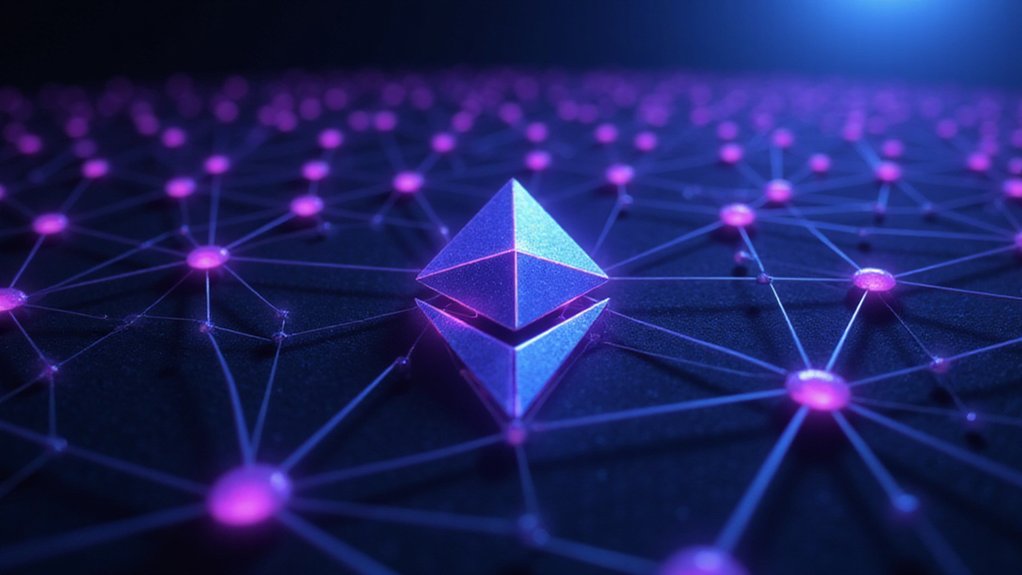Polygon (MATIC) evolved from its 2017 Matic Network origins into Ethereum’s premier scaling solution, addressing the network’s notorious congestion with faster transactions and reduced fees. Its multi-layered approach—combining Proof of Stake security, plasma sidechains, and zkEVM technology—allows seamless migration of Ethereum projects while maintaining compatibility. With over 250 decentralized applications and millions of processed transactions, MATIC tokens power this expanding ecosystem through governance and operational functionality. The Polygon 2.0 roadmap promises even greater scaling frontiers.

In the byzantine world of blockchain technology, where scalability issues have become the Achilles’ heel of many promising protocols, Polygon (formerly Matic Network) has emerged as a formidable contender in addressing Ethereum’s well-documented limitations.
Launched in 2017, this Layer 2 scaling solution has transformed from its humble beginnings as Matic Network into an extensive framework that offers faster transactions and substantially reduced fees—a welcome reprieve for users fatigued by Ethereum’s congestion woes.
Polygon’s technological architecture employs multiple scaling approaches with impressive versatility.
Polygon’s multi-faceted scaling mechanisms deliver unparalleled flexibility in a landscape demanding technological sophistication.
Its primary infrastructure leverages a Proof of Stake chain, complemented by plasma sidechains that were part of its original design. The network selects validators who stake their cryptocurrency to maintain security and process transactions efficiently.
The platform hasn’t rested on its laurels, however; plans to integrate Optimistic Rollups and other advanced scaling technologies signal its commitment to evolving alongside the broader crypto ecosystem.
This multi-pronged strategy positions Polygon as more than a mere band-aid solution—it represents a fundamental reimagining of how Ethereum can function at scale.
The Polygon zkEVM stands out as an EVM-equivalent rollup that ensures developers can seamlessly transfer their existing Ethereum projects without modification.
The network’s native MATIC token serves dual purposes within the ecosystem: facilitating transactions and enabling governance participation. Users can securely manage their MATIC investments through the Matic Wallet integration. This token economy creates a self-sustaining environment where network security and operational efficiency are intrinsically linked to token performance (a clever alignment of incentives, one might observe).
Perhaps most telling of Polygon’s impact is its robust adoption metrics—with over 250 decentralized applications and millions of processed transactions, it has clearly struck a chord with developers seeking refuge from Ethereum’s prohibitive gas fees.
The platform effectively transforms Ethereum into a multi-chain ecosystem, allowing projects to select the scaling solution that best suits their particular needs.
Looking forward, Polygon’s ambitious Polygon 2.0 vision aims to scale virtually every conceivable use case.
As blockchain technology continues its inexorable march toward mainstream adoption, Polygon’s role as Ethereum’s scaling solution becomes not merely useful but potentially essential for the ecosystem’s long-term viability.
Frequently Asked Questions
Is MATIC Staking Profitable Compared to Other Cryptocurrencies?
MATIC staking offers a respectable 2.78-4.65% annual yield—competitive, if not spectacular, in the cryptocurrency landscape.
While these returns won’t trigger financial apoplexy among yield-hunters, MATIC compensates through its robust ecosystem and Ethereum scaling advantages.
Profitability ultimately hinges on network utilization, validator saturation, and MATIC’s price trajectory.
Investors seeking pure yield might find greener pastures elsewhere, but those valuing technological fundamentals alongside reasonable returns may find MATIC’s proposition compelling.
How Does Polygon Handle Security Vulnerabilities and Potential Attacks?
Polygon implements a multi-layered security approach, combining community-powered bug bounty programs (offering rewards up to $5,000 for critical vulnerabilities), rigorous third-party audits from firms like Spearbit and CertiK, and rapid incident response protocols.
Their December 2021 response to a critical PoS Genesis contract vulnerability—which threatened $23 billion in MATIC tokens—exemplifies their methodology: transparent disclosure, swift validator coordination, and emergency hard fork implementation.
This ecosystem balances proactive vulnerability detection with reactive crisis management, leveraging both institutional diligence and white-hat community engagement.
Can MATIC Tokens Be Stored in Hardware Wallets?
Yes, MATIC tokens can indeed be stored in hardware wallets—a sensible choice for the security-conscious investor.
Ledger devices, in particular, offer robust Polygon network support through their Ledger Live interface.
These cold storage solutions provide that essential air gap between one’s digital assets and the internet’s more nefarious elements.
Hardware wallets also typically support integration with software wallets like MetaMask, allowing users to maintain security while still accessing DeFi functionalities when needed.
How Might Ethereum 2.0 Impact Polygon’s Long-Term Relevance?
Ethereum 2.0’s implementation presents both challenge and opportunity for Polygon.
While ETH’s improved scalability might diminish Polygon’s primary value proposition (who doesn’t love a good existential threat?), Polygon’s continued innovation—particularly in zkEVM technology and the Polygon CDK—positions it as complementary rather than competitive.
The network’s established ecosystem and interoperability solutions suggest it could evolve alongside Ethereum rather than be rendered obsolete.
Their symbiotic relationship may ultimately prove more durable than skeptics anticipate.
What Are the Tax Implications of Swapping ETH for MATIC?
Swapping ETH for MATIC constitutes a taxable event in most jurisdictions, triggering capital gains calculations based on the difference between acquisition cost and fair market value at exchange time.
Taxpayers must meticulously document these transactions for annual reporting requirements—a task that, mercifully, various crypto tax software platforms now streamline.
The precise tax treatment varies by jurisdiction (some tax authorities being more voracious than others), necessitating awareness of local regulations and potentially professional consultation for complex portfolio situations.









